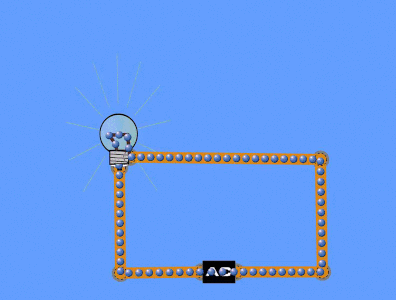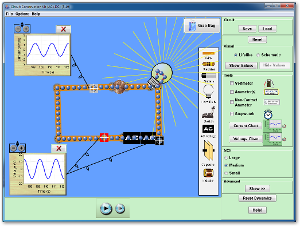Alternating current
Alternating current (AC) is the type of electric current generated by the vast majority of power plants and used by most power distribution systems. Alternating current is easier to generate and transmitting alternating current leads to lower energy losses than direct current over distances more than a few metres.[1] Although for very long distances (more than 1000 km), direct current can often be better. As opposed to direct current, the direction and amperage of alternating current changes many times a second.
Properties

An alternating current will flip the direction of charge flow (60 times a second in North America (60 Hz) and 50 times a second in Europe (50 Hz)). This is usually caused by a sinusoidally varying current and voltage that reverses directions, creating a periodic back and forth motion for the current (see Figure 1). Despite this current flowing back and forth many times a second, the energy still essentially flows continuously from the power plant to the electronic devices.
A major advantage of alternating current is that its voltage can be modified relatively easily using a transformer, which allows power to be transmitted at very high voltages before being taken down to safer voltages for commercial and residential use.[3] This minimizes energy losses, as shown below[4] (see residential household circuits for more details):
The power transmitted down the line however has a different expression:
- P is the power, either lost or transmitted and is measured in watts
- I is the electric current through the wire, measured in amperes
- V is the voltage, measured in volts
- R is the resistance, measured in ohms
As seen in the first equation, the power lost through transmission is proportional to the square of the current through the wire. Therefore, it is preferable to minimize the current through the wire so that the energy loss is reduced. Of course, minimizing the resistance would reduce the energy lost as well, but the current has a much larger impact on the amount of energy lost due to its value being squared. The second equation shows that if voltage is increased, the current is decreased equivalently to transmit the same power. Hence, the voltage through transmission lines is very high, which reduces the current, which in turn minimizes the energy lost through transmission. This is why alternating current is preferred over direct current for transmitting electricity, as it is much cheaper to change the voltage of an alternating current. However, there is a limit at which it is no longer advantageous to use alternating current over direct current (see HVDC transmission).
Uses and Advantages
Most devices (large factory dynamos for example) that are directly connected to the electrical grid operate on alternating current, and electrical outlets in homes and commercial areas supply alternating current as well. Devices that require direct current, like laptops, usually have an AC adapter that converts alternating current to direct current.[5]
Alternating current is the current of choice globally as it has many clear advantages compared to direct current. For a full breakdown of differences between the two, see AC vs DC. Some advantages include:[6]
- Cheap and efficient voltage stepping by use of transformers. As explained above this allows for energy efficient electrical transmission via powerlines. This efficient transmission saves power companies and the consumer lots of money, and helps reduce pollution since power plants do not need to make up for lost electricity by using more fuel.
- Low maintenance costs of high speed AC motors.
- Easy to interrupt the current (ie. with a circuit breaker) due to the current going to zero naturally every 1/2 cycle. For example, a circuit breaker can interrupt about 1/20th as much DC as AC current.
Phet Simulation
The University of Colorado has graciously allowed us to use the following Phet simulation that explores how alternating current works.
For further reading
For further information please see the related pages below:
- Direct current
- Energy for electricity by country
- Electrical grid
- Electric generator
- or explore a random page!
References
- ↑ M. Brain et al. How Electricity Works [Online]. Available:http://science.howstuffworks.com/electricity8.htm
- ↑ http://phet.colorado.edu/sims/circuit-construction-kit/circuit-construction-kit-ac_en.jnlp
- ↑ What is alternating current (AC)? [Online]. Available:http://www.allaboutcircuits.com/vol_2/chpt_1/1.html
- ↑ Power Dissipated in a Resistor [Online]. Available: http://hyperphysics.phy-astr.gsu.edu/hbase/electric/elepow.html#c2
- ↑ What's the difference between AC and DC? [Online]. Available: http://engineering.mit.edu/ask/what%E2%80%99s-difference-between-ac-and-dc
- ↑ Private communication with M. Pigman power engineer for Tacoma Power, Sept. 17th, 2015.


